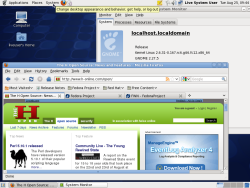First Fedora 12 pre-release version released

![]() The Fedora 12 Alpha.
As the developers have announced, the Fedora Project has made the first and only alpha version of Fedora 12, codename Constantine, available to download – as ever a little later than originally planned. Since this version has already been through "Feature Freeze", the alpha release includes all of the major changes for the forthcoming Fedora 12, which is scheduled for an early November release.
The Fedora 12 Alpha.
As the developers have announced, the Fedora Project has made the first and only alpha version of Fedora 12, codename Constantine, available to download – as ever a little later than originally planned. Since this version has already been through "Feature Freeze", the alpha release includes all of the major changes for the forthcoming Fedora 12, which is scheduled for an early November release.
This includes the switch to compressing the RPM package using the XZ format, familiar from recent versions of LZMA. The Fedora development team have also made a few changes to achieve better kernel and software performance on more recent x86-32 systems. As a consequence, the forthcoming version of Fedora will no longer run on i586 CPUs such as VIA C3 processors with Ezra and Samuel cores or AMD's Geode GX.
Fedora 12 will offer the GNOME 2.28 and KDE 4.3 desktops – not that the latter can really be classified as a new feature, with Fedora 11, originally shipped with KDE 4.2, being upgraded to the latest version of KDE as part of the standard update mechanism from today. The development team have also integrated parts of Moblin. In place of Mono-based notepad application Tomboy, Fedora will in future install Gnote, a port of Tomboy to C++.
The development team are rejigging the audio mixer for GNOME, introduced in Fedora 11, to give the roundly criticised program better visuals. The Fedora/Red Hat development team have also made many changes to the much maligned PulseAudio, used by the GNOME mixer software, including adding UPnP MediaServer support and surround audio support for event sounds.
The alpha release uses a development version of X.org 7.5 which includes X Server 1.7 and support for X Input Extension 2.0 (XI2). The latest version of X.org was scheduled for release about now, but the X team have yet to release even a pre-release version, so that several more weeks are likely to pass before completion. The current versions of AMD and NVIDIA's proprietary graphics drivers do not run under the Fedora alpha, but a beta version of the forthcoming NVIDIA driver is reported to do so.
The kernel version shipped with the alpha is a pre-release version of Linux 2.6.31. Instead of a system specific initial ramdisk (initrd) generated using mkinitrd during kernel installation, Fedora 12 will use the generic, modular Dracut. Kernel-based mode setting (KMS) is now also used by default on NVIDIA cards. With the aid of MDRaid, an up-to-date version of Mdamd, the installer is now able to install to host/fake RAID 5 arrays used with modern Intel motherboard chip-sets. The GRUB version used by Fedora now offers Ext4 support, with the consequence that a separate boot partition is not necessarily required when using Ext4 as the root partition.
There have been many enhancements in the area of virtualisation. The use of the qcow2 image format in KVM should, for example, improve I/O performance. KSM (Kernel Shared Memory / Kernel Samepage Merging), explained in detail in the Proceedings of the Linux Symposium 2009, promises to reduce memory usage. Also new is support for SR-IOV (Single Root I/O Virtualisation), which allows PCI devices which support SR-IOV to be divided into multiple virtual devices which can be assigned to different virtualised guest systems.
A few further new features in Fedora 12:
- A number of enhancements to power management
- Substantially revised PolicyKit
- Introduction of the Automated Bug-Reporting Tool (ABRT 1.0)
- Better support for establishing internet connections via mobile phones and other hand held devices using NetworkManager
- NetworkManager is now able to manage system-wide network connections
In its stage of development, the alpha version roughly corresponds to the test 2 or beta pre-release version in previous Fedora releases. This is the result of a decision made a few weeks ago that for future releases there would be only two test versions per development cycle with a slightly different nomenclature for these two versions – the beta version scheduled for release in five weeks time will roughly correspond to the test 3 or 'preview release' versions from earlier versions. As usual with Fedora, the current state of development of the forthcoming Fedora release can be tested as required by installing the current Rawhide development version, which is updated pretty much daily. One Fedora community member has recently started to place live spins of daily updates of Rawhide online to allow users to test Rawhide without having to install it.
(crve)
![Kernel Log: Coming in 3.10 (Part 3) [--] Infrastructure](/imgs/43/1/0/4/2/6/7/2/comingin310_4_kicker-4977194bfb0de0d7.png)

![Kernel Log: Coming in 3.10 (Part 3) [--] Infrastructure](/imgs/43/1/0/4/2/3/2/3/comingin310_3_kicker-151cd7b9e9660f05.png)
















